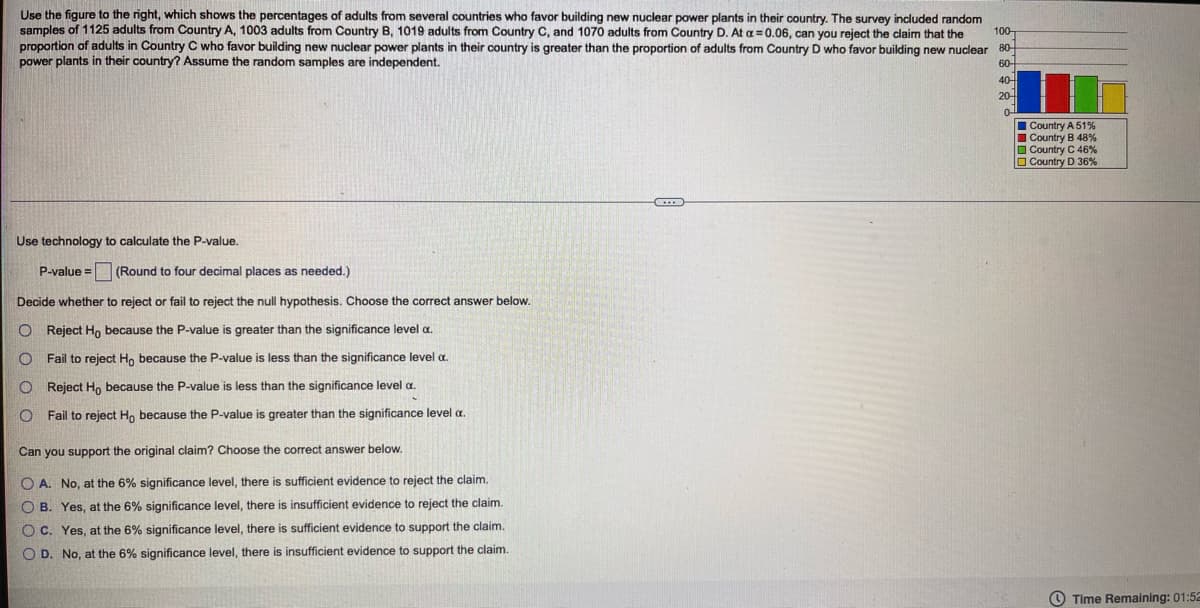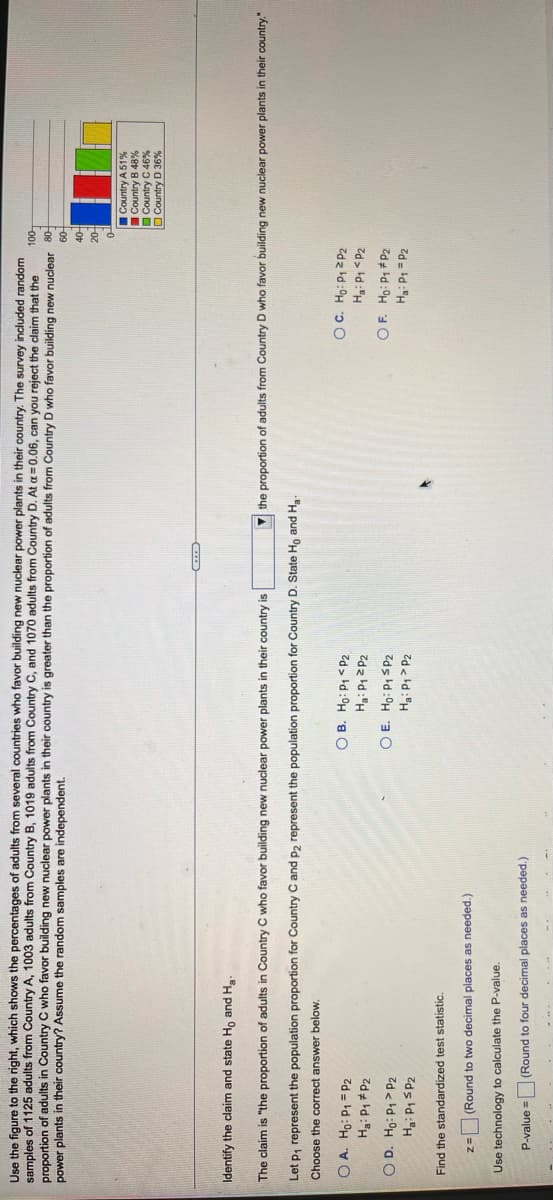figure to the nght, hich shows the percentages of adults from several countries who favor building new nuclear power plants in their country. The survey included random samples of 1125 adults from Country A, 1003 adults from Country B, 1019 adults from Country C, and 1070 adults from Country D. At a=0.06, can you reject the claim that the proportion of adults in Country C who favor building new nuclear power plants in their country is greater than the proportion of adults from Country D who favor building new nuclear 80- power plants in their country? Assume the random samples are independent. 100- 60- 40- 20 I Country A 51% ICountry B 48% O Country C 46% O Country D 36% Use technology to calculate the P-value. P-value = (Round to four decimal places as needed.) Decide whether to reject or fail to reject the null hypothesis. Choose the correct answer below. O Reject Ho because the P-value is greater than the significance level a. O Fail to reject H, because the P-value is less than the significance level a. O Reject Ho because the P-value is less than the significance level a. O Fail to reject Ho because the P-value is greater than the significance level a. Can you support the original claim? Choose the correct answer below.
figure to the nght, hich shows the percentages of adults from several countries who favor building new nuclear power plants in their country. The survey included random samples of 1125 adults from Country A, 1003 adults from Country B, 1019 adults from Country C, and 1070 adults from Country D. At a=0.06, can you reject the claim that the proportion of adults in Country C who favor building new nuclear power plants in their country is greater than the proportion of adults from Country D who favor building new nuclear 80- power plants in their country? Assume the random samples are independent. 100- 60- 40- 20 I Country A 51% ICountry B 48% O Country C 46% O Country D 36% Use technology to calculate the P-value. P-value = (Round to four decimal places as needed.) Decide whether to reject or fail to reject the null hypothesis. Choose the correct answer below. O Reject Ho because the P-value is greater than the significance level a. O Fail to reject H, because the P-value is less than the significance level a. O Reject Ho because the P-value is less than the significance level a. O Fail to reject Ho because the P-value is greater than the significance level a. Can you support the original claim? Choose the correct answer below.
Holt Mcdougal Larson Pre-algebra: Student Edition 2012
1st Edition
ISBN:9780547587776
Author:HOLT MCDOUGAL
Publisher:HOLT MCDOUGAL
Chapter11: Data Analysis And Probability
Section: Chapter Questions
Problem 8CR
Related questions
Question

Transcribed Image Text:Use the figure to the right, which shows the percentages of adults from several countries who favor building new nuclear power plants in their country. The survey included random
samples of 1125 adults from Country A, 1003 adults from Country B, 1019 adults from Country C, and 1070 adults from Country D. At a =0.06, can you reject the claim that the
proportion of adults in Country C who favor building new nuclear power plants in their country is greater than the proportion of adults from Country D who favor building new nuclear 80-
100-
power plants in their country? Assume the random samples are independent.
60-
40-
20-
0-
I Country A 51%
I Country B 48 %
O Country C 46%
O Country D 36%
Use technology to calculate the P-value.
P-value = (Round to four decimal places as needed.)
Decide whether to reject or fail to reject the null hypothesis. Choose the correct answer below.
O Reject Ho because the P-value is greater than the significance level a.
O Fail to reject Ho because the P-value is less than the significance level a.
O Reject Ho because the P-value is less than the significance level a.
O Fail to reject H, because the P-value is greater than the significance level a.
Can you support the original claim? Choose the correct answer below.
O A. No, at the 6% significance level, there is sufficient evidence to reject the claim.
O B. Yes, at the 6% significance level, there is insufficient evidence to reject the claim.
O C. Yes, at the 6% significance level, there is sufficient evidence to support the claim.
O D. No, at the 6% significance level, there is insufficient evidence to support the claim.
O Time Remaining: 01:52

Transcribed Image Text:Use the figure to the right, which shows the percentages of adults from several countries who favor building new nuclear power plants in their country. The survey included random
samples of 1125 adults from Country A, 1003 adults from Country B, 1019 adults from Country C, and 1070 adults from Country D. At a =0.06, can you reject the claim that the
proportion of adults in Country C who favor building new nuclear power plants in their country is greater than the proportion of adults from Country
power plants in their country? Assume the random samples are independent.
-00L
who favor building new nuclear
09
ICountry A 51%
I Country B 48%
O Country C 46%
O Country D 36%
Identify the claim and state Ho and Ha
The claim is "the proportion of adults in Country C who favor building new nuclear power plants
their country is
M the proportion of adults from Country D who favor building new nuclear power plants in their country."
Let p, represent the population proportion for Country C and P2 represent the population proportion for Country D. State Ho and Ha-
Choose the correct answer below.
O B. Ho: P1 <P2
O C. Ho: P1 2 P2
O A. Ho: P1 = P2
Hạ: P1P2
Zdz ld:"H
Zd> bd:"H
O E. Ho: P1 SP2
OF. Ho: P1 * P2
O D. Ho: P1> P2
Ha: P1 = P2
Zd < bd :H
Find the standardized test statistic.
z= (Round to two decimal places as needed.)
Use technology to calculate the P-value.
P-value = (Round to four decimal places as needed.)
Expert Solution
This question has been solved!
Explore an expertly crafted, step-by-step solution for a thorough understanding of key concepts.
This is a popular solution!
Trending now
This is a popular solution!
Step by step
Solved in 2 steps

Recommended textbooks for you

Holt Mcdougal Larson Pre-algebra: Student Edition…
Algebra
ISBN:
9780547587776
Author:
HOLT MCDOUGAL
Publisher:
HOLT MCDOUGAL

Holt Mcdougal Larson Pre-algebra: Student Edition…
Algebra
ISBN:
9780547587776
Author:
HOLT MCDOUGAL
Publisher:
HOLT MCDOUGAL